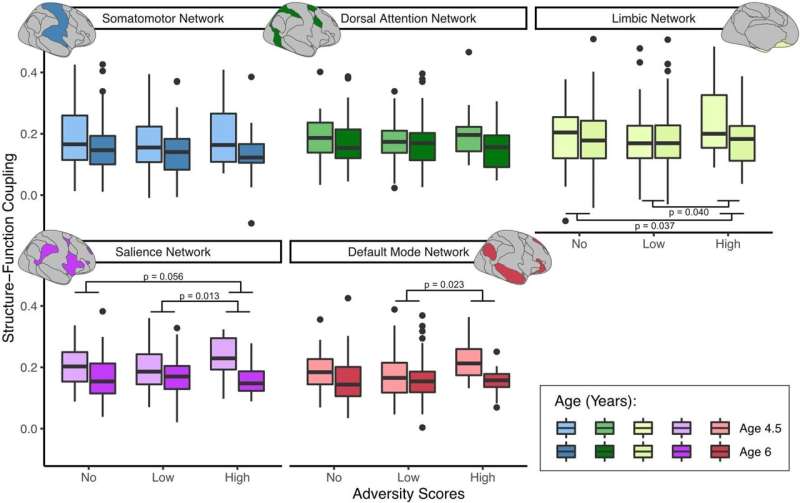This article has been reviewed according to Science X's editorial process and policies. Editors have highlighted the following attributes while ensuring the content's credibility:
fact-checked
peer-reviewed publication
trusted source
proofread
Study reveals impact of early life adversity on a child's brain development

Researchers have found evidence suggesting that children exposed to elevated levels of early life adversity (ELA) exhibit an accelerated pattern of brain development during the preschool years. When exposed to ELA, such as a mother's mental and physical health challenges during pregnancy, the child's brain undergoes accelerated development in order to adapt to the adverse circumstances.
This hastened pace of brain development could lead to a higher risk of adverse cognitive and mental health outcomes. The paper, "The influence of early-life adversity on the coupling of structural and functional brain connectivity across childhood," was published in Nature Mental Health on 4 January 2024.
Exposure to ELA is a recognized risk factor for poor health outcomes throughout life. This includes an increased risk of cognitive impairment as well as the development of mental health disorders such as major depressive disorders.
Exposure to ELA in the prenatal period triggers changes in the pace of brain development across childhood, most prominent during the preschool period—a crucial time window whereby experience-dependent learning and adaptation set the stage for future brain function.
Previous studies suggest that "accelerated brain development" is an adaptive mechanism to early life challenges and may mediate the association between ELA and poor mental health and cognitive outcomes.
To effectively quantify the impact of ELA, the research team adopted a scoring framework created by Professor Patricia Silveira at McGill University, to produce a composite score of ELA which considered factors that extend across a population.
These factors focused on exposures experienced before birth, encompassing the mother's mental and physical health during pregnancy as well as the family's structure and financial circumstances. When we add up or combine different risk factors, it gives us a better prediction of a child's outcome.
Using this composite score, the study team stratified the GUSTO cohort into different levels of cumulative ELA exposure. The pace of brain development was then examined across children exposed to different levels of ELA.
To model the pace of brain development across childhood, the study team utilized multi-modal MRI scans from the GUSTO birth cohort. These MRI brain scans were acquired from 549 children at three time points, ages 4.5, 6.0 and 7.5 years, allowing the study team to examine the link between ELA and brain development in a longitudinal manner.
As most mental health disorders have roots in childhood, the study of developmental trajectories in a longitudinal manner is strongly relevant.
In this study, a measure that combines structural connectivity and functional connectivity of the brain was used to provide insights into the association between brain structure and function. This measure, known as structure-function coupling (SC-FC), reflects a child's potential for neuroplasticity, the brain's ability to adapt and reorganize itself to learn, recover from injury, and adjust to new experiences.
In early childhood, the brain is expected to be less specialized and more adaptable, matching a decreasing trajectory of SC-FC over childhood.
Led by Dr. Tan Ai Peng, Principal Investigator with A*STAR's Singapore Institute for Clinical Sciences (SICS) and clinician with National University Hospital, along with Dr. Chan Shi Yu, a researcher at A*STAR's SICS, the study found that exposure to high levels of ELA is linked to a faster decline in SC-FC between ages 4.5 and 6, indicating accelerated brain development.
This accelerated pattern of brain development is likely an adaptive mechanism when exposed to environmental cues that requires "maturity." Although this is meant to be a 'protective mechanism' against adversity, it does have negative implications in the long term as it results in a shorter window of neuroplasticity and adaptive learning. Notably, results from this study pinpoint the period between ages 4.5 and 6 years as a potential window for early intervention to improve outcomes for children who were exposed to ELA.
"Our study provided evidence that exposure to early-life challenges affects the pace of brain development across childhood. This, in turn, has significant effects on future cognitive and mental health outcomes. If we can develop screening tools to detect accelerated brain development, we will be able to implement interventions earlier, and prevent cascading consequences of accelerated brain development for mental health," said, Dr. Tan Ai Peng
Already looking forward, the researchers have identified important areas for future investigation—determining whether ELA's effects on accelerated brain development across childhood set the stage for premature brain aging in later stages of life, and the effectiveness of intervention strategies that could mitigate the effects of ELA exposure such as the promotion of psychological resilience through cognitive behavioral therapy.
More information: Shi Yu Chan et al, The influence of early-life adversity on the coupling of structural and functional brain connectivity across childhood, Nature Mental Health (2024). DOI: 10.1038/s44220-023-00162-5


















